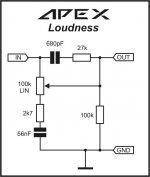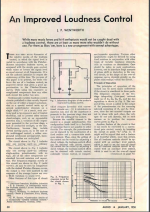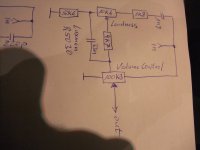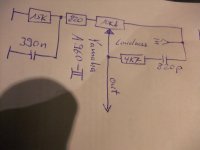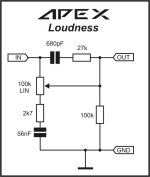First a merry christmas weekend for everyone.
Mostly usual in integrated amplifiers is a level dependent loudness effect - for this an attenuator with tap in the first third or quarter of a 270 degree potentiometers is necessary - go to
https://vajacases46-com.myshopify.com/products/radioshack-100k-dual-ganged-stereo-volume-control
and
Using tap potentiometer loudness circuit under Meter Counter Circuits -60631- : Next.gr
But there are to accept two great disadvantages:
1) If there are low level or very high level input sources at the integrated amplifier, there is no possibility of moving this tap, i. e., the effect of the midrange attenuation is too weak or too strong.
2) If there is necessary the replacing of that pot, no genuine part is available (except an identical amp model is present for spare parts), i. e. with usual three-pin pot the loudness option isn't longer available.
By checking some service manuals of integrated amplifiers for a helpful solution, I note, that Luxman's R5030 used at least an additional loudness potentiometer for adjusting resp. for the stepless setting of the loudness effect resp. the midrange attenuation - go to page 15 under
LUXMAN R-5030 SM Service Manual download, schematics, eeprom, repair info for electronics experts
Yamaha's AX-570 does the same, but without a tap on the volume attenuator resp. volume control pot - go to
YAMAHA AX-570 SM Service Manual download, schematics, eeprom, repair info for electronics experts
and
https://web.archive.org/web/20210623113458/https://www.schematicsforfree.com/archive/file/Audio/Circuits/Equalizers, Filters & Tone Controls/Loudness Controls/APEX Loudness Control.jpg
Unfortunately the loudness characteristic resp. the individual cut-off frequencies are different at all brands - each manufacturer use his own concept therefore.
After the long preface, now the question:
Which details do I have to pay attention to when converting the level dependent loudness circuit from Luxman's L190 - go to
LUXMAN L-190A Service Manual download, schematics, eeprom, repair info for electronics experts
to level independent loudness like from Yamaha's AX-570 while maintaining of the characteristic resp. the individual cut-off frequencies for the attenuated midrange of Luxman's L190 ?
If I know this, I order a usual pot without tap for loudness and I would then use the balance control potentiometer for the loudness control, because the balance control isn't absolutely necessary by the currently user.
Thank you very much for an advice and appropriate links.
Level-dependent loudness approaches
switched version - one position (loudness on/off) increasing low and high frequency area at low volume level - 4-pin (tapped) pot in use
https://www.extron.de/article/loudnesscontrol_ts
https://www.extron.com/article/loudnesscontrol_ts
http://kit-amp.com/alps-rk27-volume-control-loudness-en
https://www.eevblog.com/forum/repair/loudness-tap-in-old-audio-potentiometers/ (reply #8)
https://www.angelfire.com/electronic/funwithtubes/Amp-Volume.html
https://www.eleccircuit.com/audio-loudness-control/
switched version - one position (loudness on/off) increasing only low frequency area at low level volume - 4-pin (tapped) pot in use
https://elektrotanya.com/luxman_l-190a.pdf/download.html
switched version - one position (loudness on/off) increasing only low frequency area at low level volume - 3-pin (no tapped) pot in use
https://www.diyaudio.com/community/threads/volume-control-with-loudness-and-no-taps.173029/ (post #10)
https://www.radiomuseum.org/forum/gehoerrichtige_lautataerkeregelung_mit_potis_ohne_anzapfungen.html
unswitched version with two-tapped potentiometer
https://elektrotanya.com/grundig_sv-2000_gb_u.pdf/download.html
https://www.diyaudio.com/community/threads/modifications-to-loudness-circuit.317194/ (post #7)
unswitched version - increasing low and high frequency area at low level volume - 3-pin (no tapped) pot in use
https://www.diyaudio.com/community/threads/how-preserve-loudness-circuit-with-new-volume-pot.189463/ (post #7)
http://www.dl4cs.de/audio/preamps/loudness/index.htm
Variable loudness version with triplet potentiometer
https://www.worldradiohistory.com/h...Electronics-1951-07-OCR-Page-0041.pdf#search="build%20variable%20loudness%20control"
https://www.worldradiohistory.com/Archive-Radio-Electronics/50s/1953/Radio-Electronics-1953-10.pdf (pg. 42)
Level-independent variable loudness approaches:
https://web.archive.org/web/2021062...s/Loudness Controls/APEX Loudness Control.jpg
https://elektrotanya.com/yamaha_ax-530.pdf/download.html (Loudness of Yamaha's AX530 identical to APEX Loudness)
https://www.hifiengine.com/news/yamaha-a-960-ii.shtml (Yamaha A-960 II)
https://www.tubecad.com/2021/08/blog0542.htm
switched version - two positions increasing only low frequency area at low level - only switch in use
https://www.worldradiohistory.com/h...-IDX/IDX/50s/Audio-1958-Jan-OCR-Page-0024.pdf
commonly basics
https://www.diyaudio.com/community/threads/loudness-stage.202413/
https://www.sfxmachine.com/docs/loudnesswar/loudness_war.pdf
https://www.next.gr/meter-counter/Using-tap-potentiometer-loudness-circuit-l60631.html (various topologies, overview)
https://www.diyaudio.com/community/threads/loudness-stage.202413/
https://www.diyaudio.com/community/...and-single-d-shaft-custom-made-or-not.396070/
https://www.diyaudio.com/community/threads/variable-loudness-diy-for-noob.381420/
https://www.diyaudio.com/community/threads/loudness-experiences.77599/
https://www.diyaudio.com/community/threads/reverse-of-the-old-loudness-control.154209/
https://www.diyaudio.com/community/threads/volume-control-with-loudness-and-no-taps.173029/
https://www.diyaudio.com/community/threads/faking-a-loudness-tap.294388/
https://www.diyaudio.com/community/threads/loudness-circuit-modification.361845/
https://www.diyaudio.com/community/threads/loudness-control.30290/
https://www.diyaudio.com/community/threads/loudness-controls.214490/
https://www.diyaudio.com/community/threads/loudness-stage.202413/
https://www.vintage-radio.net/forum/showthread.php?p=854290
https://www.audiokarma.org/forums/i...-control-do-any-integrateds-have-this.423382/
https://audiokarma.org/forums/index.php?threads/variable-loudness.496773/
https://www.audiosciencereview.com/...one-control-especially-the-schiit-loki.17996/
Loudness Meter
https://web.archive.org/web/20120404192304/https://www.grimmaudio.com/pro_software_levelview.htm
Mostly usual in integrated amplifiers is a level dependent loudness effect - for this an attenuator with tap in the first third or quarter of a 270 degree potentiometers is necessary - go to
https://vajacases46-com.myshopify.com/products/radioshack-100k-dual-ganged-stereo-volume-control
and
Using tap potentiometer loudness circuit under Meter Counter Circuits -60631- : Next.gr
But there are to accept two great disadvantages:
1) If there are low level or very high level input sources at the integrated amplifier, there is no possibility of moving this tap, i. e., the effect of the midrange attenuation is too weak or too strong.
2) If there is necessary the replacing of that pot, no genuine part is available (except an identical amp model is present for spare parts), i. e. with usual three-pin pot the loudness option isn't longer available.
By checking some service manuals of integrated amplifiers for a helpful solution, I note, that Luxman's R5030 used at least an additional loudness potentiometer for adjusting resp. for the stepless setting of the loudness effect resp. the midrange attenuation - go to page 15 under
LUXMAN R-5030 SM Service Manual download, schematics, eeprom, repair info for electronics experts
Yamaha's AX-570 does the same, but without a tap on the volume attenuator resp. volume control pot - go to
YAMAHA AX-570 SM Service Manual download, schematics, eeprom, repair info for electronics experts
and
https://web.archive.org/web/20210623113458/https://www.schematicsforfree.com/archive/file/Audio/Circuits/Equalizers, Filters & Tone Controls/Loudness Controls/APEX Loudness Control.jpg
Unfortunately the loudness characteristic resp. the individual cut-off frequencies are different at all brands - each manufacturer use his own concept therefore.
After the long preface, now the question:
Which details do I have to pay attention to when converting the level dependent loudness circuit from Luxman's L190 - go to
LUXMAN L-190A Service Manual download, schematics, eeprom, repair info for electronics experts
to level independent loudness like from Yamaha's AX-570 while maintaining of the characteristic resp. the individual cut-off frequencies for the attenuated midrange of Luxman's L190 ?
If I know this, I order a usual pot without tap for loudness and I would then use the balance control potentiometer for the loudness control, because the balance control isn't absolutely necessary by the currently user.
Thank you very much for an advice and appropriate links.
Level-dependent loudness approaches
switched version - one position (loudness on/off) increasing low and high frequency area at low volume level - 4-pin (tapped) pot in use
https://www.extron.de/article/loudnesscontrol_ts
https://www.extron.com/article/loudnesscontrol_ts
http://kit-amp.com/alps-rk27-volume-control-loudness-en
https://www.eevblog.com/forum/repair/loudness-tap-in-old-audio-potentiometers/ (reply #8)
https://www.angelfire.com/electronic/funwithtubes/Amp-Volume.html
https://www.eleccircuit.com/audio-loudness-control/
switched version - one position (loudness on/off) increasing only low frequency area at low level volume - 4-pin (tapped) pot in use
https://elektrotanya.com/luxman_l-190a.pdf/download.html
switched version - one position (loudness on/off) increasing only low frequency area at low level volume - 3-pin (no tapped) pot in use
https://www.diyaudio.com/community/threads/volume-control-with-loudness-and-no-taps.173029/ (post #10)
https://www.radiomuseum.org/forum/gehoerrichtige_lautataerkeregelung_mit_potis_ohne_anzapfungen.html
unswitched version with two-tapped potentiometer
https://elektrotanya.com/grundig_sv-2000_gb_u.pdf/download.html
https://www.diyaudio.com/community/threads/modifications-to-loudness-circuit.317194/ (post #7)
unswitched version - increasing low and high frequency area at low level volume - 3-pin (no tapped) pot in use
https://www.diyaudio.com/community/threads/how-preserve-loudness-circuit-with-new-volume-pot.189463/ (post #7)
http://www.dl4cs.de/audio/preamps/loudness/index.htm
Variable loudness version with triplet potentiometer
https://www.worldradiohistory.com/h...Electronics-1951-07-OCR-Page-0041.pdf#search="build%20variable%20loudness%20control"
https://www.worldradiohistory.com/Archive-Radio-Electronics/50s/1953/Radio-Electronics-1953-10.pdf (pg. 42)
Level-independent variable loudness approaches:
https://web.archive.org/web/2021062...s/Loudness Controls/APEX Loudness Control.jpg
https://elektrotanya.com/yamaha_ax-530.pdf/download.html (Loudness of Yamaha's AX530 identical to APEX Loudness)
https://www.hifiengine.com/news/yamaha-a-960-ii.shtml (Yamaha A-960 II)
https://www.tubecad.com/2021/08/blog0542.htm
switched version - two positions increasing only low frequency area at low level - only switch in use
https://www.worldradiohistory.com/h...-IDX/IDX/50s/Audio-1958-Jan-OCR-Page-0024.pdf
commonly basics
https://www.diyaudio.com/community/threads/loudness-stage.202413/
https://www.sfxmachine.com/docs/loudnesswar/loudness_war.pdf
https://www.next.gr/meter-counter/Using-tap-potentiometer-loudness-circuit-l60631.html (various topologies, overview)
https://www.diyaudio.com/community/threads/loudness-stage.202413/
https://www.diyaudio.com/community/...and-single-d-shaft-custom-made-or-not.396070/
https://www.diyaudio.com/community/threads/variable-loudness-diy-for-noob.381420/
https://www.diyaudio.com/community/threads/loudness-experiences.77599/
https://www.diyaudio.com/community/threads/reverse-of-the-old-loudness-control.154209/
https://www.diyaudio.com/community/threads/volume-control-with-loudness-and-no-taps.173029/
https://www.diyaudio.com/community/threads/faking-a-loudness-tap.294388/
https://www.diyaudio.com/community/threads/loudness-circuit-modification.361845/
https://www.diyaudio.com/community/threads/loudness-control.30290/
https://www.diyaudio.com/community/threads/loudness-controls.214490/
https://www.diyaudio.com/community/threads/loudness-stage.202413/
https://www.vintage-radio.net/forum/showthread.php?p=854290
https://www.audiokarma.org/forums/i...-control-do-any-integrateds-have-this.423382/
https://audiokarma.org/forums/index.php?threads/variable-loudness.496773/
https://www.audiosciencereview.com/...one-control-especially-the-schiit-loki.17996/
Loudness Meter
https://web.archive.org/web/20120404192304/https://www.grimmaudio.com/pro_software_levelview.htm
Last edited:
Yes and a good solution to avoid the second disadvantage mentioned in my post #1.
Unfortunately not the first mentioned disadvantage.
I want to have a volume control and a variable loundness control that work independently of each other. Cut-off frequencies of the frequency response with max. loudness effect of Luxman's L190 (which roughly corresponds to the 9 o'clock position of volume control) should be the same.
How I find the right topology and how I must calculate the values of all parts (genuine pot for volume control 100K, on its loudness-tap serial network with 47n/10K to GND, loudness OFF-position means shorting 47n capacitor) ?
Unfortunately not the first mentioned disadvantage.
I want to have a volume control and a variable loundness control that work independently of each other. Cut-off frequencies of the frequency response with max. loudness effect of Luxman's L190 (which roughly corresponds to the 9 o'clock position of volume control) should be the same.
How I find the right topology and how I must calculate the values of all parts (genuine pot for volume control 100K, on its loudness-tap serial network with 47n/10K to GND, loudness OFF-position means shorting 47n capacitor) ?
Last edited:
in the attachment the wanted topology (also according Yamaha AX570 and several DENON integrated and pre-amp devices using other values for capacitors and resistors for different cut-off frequencies) and an other approach (switched instead variable) - both independent of the position of volume control.
Who can upload page 71 ?
several additional URL's:
Amplifier volume and loudness controls.
Audio loudness control | ElecCircuit.com
Using tap potentiometer loudness circuit under Meter Counter Circuits -60631- : Next.gr
Denon Variable Loudness control - do any Integrateds have this? | Audiokarma Home Audio Stereo Discussion Forums
Variable Loudness | Audiokarma Home Audio Stereo Discussion Forums
https://www.schematicsforfree.com/a...s/Loudness Controls/APEX Loudness Control.jpg
https://www.audiosciencereview.com/...one-control-especially-the-schiit-loki.17996/
Who can upload page 71 ?
several additional URL's:
Amplifier volume and loudness controls.
Audio loudness control | ElecCircuit.com
Using tap potentiometer loudness circuit under Meter Counter Circuits -60631- : Next.gr
Denon Variable Loudness control - do any Integrateds have this? | Audiokarma Home Audio Stereo Discussion Forums
Variable Loudness | Audiokarma Home Audio Stereo Discussion Forums
https://www.schematicsforfree.com/a...s/Loudness Controls/APEX Loudness Control.jpg
https://www.audiosciencereview.com/...one-control-especially-the-schiit-loki.17996/
Attachments
Last edited:
Here additional interesting URL's both in German and English:
Loudness, Its Definition, Measurement and Calculation (Harvey Fletcher W. A. Munson)
https://www.google.de/url?sa=t&rct=...culation.pdf&usg=AOvVaw3PTFAY3KMxHZwxOo09DCC7
https://asa.scitation.org/doi/abs/10.1121/1.1915637
BSTJ 12: 4. October 1933: Loudness, Its Definition, Measurement and Calculation. (Fletcher, Harvey; Munson, W.A.) : Free Download, Borrow, and Streaming : Internet Archive
The History of Fletcher & Munson's Loudness Curves
Fletcher Munson Curve: The Equal Loudness Contour of Human Hearing
Fletcher Munson Curve: The Equal Loudness Contour of Human Hearing
Fletcher Munson Curve: The Equal Loudness Contour of Human Hearing
Was ist ein gutes Gehör ?
https://mastering-academy.de/wp-con...+02-Hörstrategien-im-Mastering_Ausschnitt.pdf
Erklärung der Fletcher-Munson Kurven
https://de.ehomerecordingstudio.com/fletcher-munson-kurve/
Gehörrichtige Lautstärke-Entzerrung
https://www.biologie-seite.de/Biologie/Gehörrichtige_Lautstärke
https://deacademic.com/dic.nsf/dewiki/447229
Normal equal-loudness level contours - ISO 226:2003
http://www.sengpielaudio.com/Acoustics226-2003.pdf
Fletcher-Munson ist nicht Robinson-Dadson
http://www.sengpielaudio.com/Fletcher-MunsonIstNichtRobinson-Dadson.pdf
Fletcher-Munson vs. Robinson-Dadson
http://www.lindos.co.uk/cgi-bin/FlexiData.cgi?SOURCE=Articles&VIEW=full&id=17
Full Revision of International Standards for Equal-Loudness Level Contours (ISO 226)
https://web.archive.org/web/2011072...e/latest_research/2003/20031114/20031114.html
"Gehörrichtige" Lautstärkeregelung und die Hörempfindlichkeit in Abhängigkeit von Frequenz und Schalldruck-Pegel
http://www.sengpielaudio.com/GehoerrichtigeLautstaerkeregelung.pdf
Precise and Full-range Determination of Two-dimensional Equal Loudness Contours
http://www.mp3-tech.org/programmer/docs/IS-01Y-E.pdf
Audio Mastering am Computer - Hörstrategien
https://www.delamar.de/mastering/audio-mastering-am-computer-hoerstrategien-1-3657/
Loudness, Its Definition, Measurement and Calculation (Harvey Fletcher W. A. Munson)
https://www.google.de/url?sa=t&rct=...culation.pdf&usg=AOvVaw3PTFAY3KMxHZwxOo09DCC7
https://asa.scitation.org/doi/abs/10.1121/1.1915637
BSTJ 12: 4. October 1933: Loudness, Its Definition, Measurement and Calculation. (Fletcher, Harvey; Munson, W.A.) : Free Download, Borrow, and Streaming : Internet Archive
The History of Fletcher & Munson's Loudness Curves
Fletcher Munson Curve: The Equal Loudness Contour of Human Hearing
Fletcher Munson Curve: The Equal Loudness Contour of Human Hearing
Fletcher Munson Curve: The Equal Loudness Contour of Human Hearing
Was ist ein gutes Gehör ?
https://mastering-academy.de/wp-con...+02-Hörstrategien-im-Mastering_Ausschnitt.pdf
Erklärung der Fletcher-Munson Kurven
https://de.ehomerecordingstudio.com/fletcher-munson-kurve/
Gehörrichtige Lautstärke-Entzerrung
https://www.biologie-seite.de/Biologie/Gehörrichtige_Lautstärke
https://deacademic.com/dic.nsf/dewiki/447229
Normal equal-loudness level contours - ISO 226:2003
http://www.sengpielaudio.com/Acoustics226-2003.pdf
Fletcher-Munson ist nicht Robinson-Dadson
http://www.sengpielaudio.com/Fletcher-MunsonIstNichtRobinson-Dadson.pdf
Fletcher-Munson vs. Robinson-Dadson
http://www.lindos.co.uk/cgi-bin/FlexiData.cgi?SOURCE=Articles&VIEW=full&id=17
Full Revision of International Standards for Equal-Loudness Level Contours (ISO 226)
https://web.archive.org/web/2011072...e/latest_research/2003/20031114/20031114.html
"Gehörrichtige" Lautstärkeregelung und die Hörempfindlichkeit in Abhängigkeit von Frequenz und Schalldruck-Pegel
http://www.sengpielaudio.com/GehoerrichtigeLautstaerkeregelung.pdf
Precise and Full-range Determination of Two-dimensional Equal Loudness Contours
http://www.mp3-tech.org/programmer/docs/IS-01Y-E.pdf
Audio Mastering am Computer - Hörstrategien
https://www.delamar.de/mastering/audio-mastering-am-computer-hoerstrategien-1-3657/
Last edited:
This loudness-control approach in the attachment by triplet potentiometer for new diy projects looks interesting.
For stereo applications this potentiometer is the appropriate part:
https://www.audiophonics.fr/en/pote...hmic-motorized-potentiometer-100k-p-2553.html
For stereo applications this potentiometer is the appropriate part:
https://www.audiophonics.fr/en/pote...hmic-motorized-potentiometer-100k-p-2553.html
Attachments
-
Loudness variable by Triplet Potentiometer.pdf84.3 KB · Views: 75
-
datenblatt-442068-alps-401951-rk16816mg-10kdx6-motor-potentiometer-staubdicht-stereo-005-w-10-...pdf236.4 KB · Views: 57
-
RK168-ALPS.pdf390.5 KB · Views: 60
-
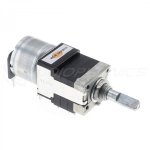 alps-rk16816mg-6-way-logarithmic-motorized-potentiometer-100k (1).jpg56 KB · Views: 46
alps-rk16816mg-6-way-logarithmic-motorized-potentiometer-100k (1).jpg56 KB · Views: 46 -
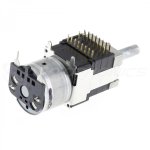 alps-rk16816mg-6-way-logarithmic-motorized-potentiometer-100k.jpg63.4 KB · Views: 42
alps-rk16816mg-6-way-logarithmic-motorized-potentiometer-100k.jpg63.4 KB · Views: 42 -
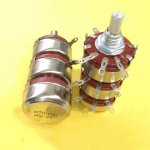 7133bpjw2EL._SL1500_.jpg117.2 KB · Views: 38
7133bpjw2EL._SL1500_.jpg117.2 KB · Views: 38 -
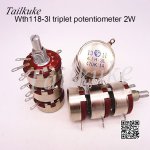 Triplet Potentiometer WTH-3L.jpg119.1 KB · Views: 44
Triplet Potentiometer WTH-3L.jpg119.1 KB · Views: 44
I am a little confused concerning the various approaches for loudness contour.
This is the reason, why I couldn't formulate my question sufficiently accurate.
In the meantime I note, that there are this wide range of loudness equalizing:
1) switched version one position (loudness on/off)
a. for low and high frequency area and
b. only low frequency area like on Luxman's L-190, L-210, L-225, L-230. L-235 (max. increase by Loudness-ON and Volume -3db: 100Hz: +8db,)
2) switched version two position (loudness 1/off/2)
a. for low and high frequency area like on Trio-Kennwood's 700C
b. only low frequency area
3) variable versions with a loudness potentiometer
a. for low and high frequency area like on Luxman R5030
(max. increase by Loudness-Control: 100Hz: +8db, 10KHz: +7,5db; actually it is a midrange lowering of the area between this mentioned two frequencies).
b. only low frequency area
All mentioned versions are realized both with tapped (4-pin) potentiometer and usual 3-pin not tapped potentiometer.
The above mentioned amplifier models operates all with tapped potentiometers, i. e., the loudness effect by more or less reduced
midrange area is level dependent - i. e. loudness effect is dependent from the position of volume control knob.
Unfortunately the currently situation don't allow correct results, because each source like cd, tuner, RIAA-stages etc. provide it's own outpult voltage - mostly in a too wide range between 0,3 volts and 1,5 volts - sometimes even more.
This is the main disadvantage for the use of loudness filter which operates level dependent - because mostly the loudness equalizing effect is clearly too strong.
BTW - the second disadvantage in case of tapped pots is the fact, that the exact outline in case of replacement is hard to find in any cases.
That is the reason, that I favor the approaches with usual 3-pin potentiometers - i. e. without additional fourth pin (tapping) for loudness.
But even on this 3-pin pot exist two versions: level dependent and level independent loudness effect.
There are even commercial amplifier models with 3-pin (not tapped) potentiometer like Sony's STR313 with level dependent loudness effect and it's disadvantage as mentioned before.
I favor clearly a level independent loudness equalizing with variable loudness potentiometer instead a loudness switch.
A commercial product, where this is implemented, is Yamaha's AX-570.
The loudness-section is connected between input and balance potentiometer as a shunt arrangement.
Unfortunately for my ears, I don't like this loudness equalizer effect from Yamaha's AX-570 as much as those from the Luxman R5030.
Now the exact question:
How I convert the approach from Luxman's R5030 in a level-independent loudness effect, when I favor the sonic character of the 9 o clock position of volume control knob.
To calculate the correct resistor and capacitor parts for an independent filter stage without integrated potentiometer, it is necessary to measure all resistors between the pins for In, Out, GND and the tapping from the volume control potentiometer used in the R5030 - so I think - go also to post #2 under
https://www.diyaudio.com/community/threads/loudness-circuit-modification.361845/
Thank you very much for your support to find out the further right steps andt the other values for converting in the Yamaha topology.
This is the reason, why I couldn't formulate my question sufficiently accurate.
In the meantime I note, that there are this wide range of loudness equalizing:
1) switched version one position (loudness on/off)
a. for low and high frequency area and
b. only low frequency area like on Luxman's L-190, L-210, L-225, L-230. L-235 (max. increase by Loudness-ON and Volume -3db: 100Hz: +8db,)
2) switched version two position (loudness 1/off/2)
a. for low and high frequency area like on Trio-Kennwood's 700C
b. only low frequency area
3) variable versions with a loudness potentiometer
a. for low and high frequency area like on Luxman R5030
(max. increase by Loudness-Control: 100Hz: +8db, 10KHz: +7,5db; actually it is a midrange lowering of the area between this mentioned two frequencies).
b. only low frequency area
All mentioned versions are realized both with tapped (4-pin) potentiometer and usual 3-pin not tapped potentiometer.
The above mentioned amplifier models operates all with tapped potentiometers, i. e., the loudness effect by more or less reduced
midrange area is level dependent - i. e. loudness effect is dependent from the position of volume control knob.
Unfortunately the currently situation don't allow correct results, because each source like cd, tuner, RIAA-stages etc. provide it's own outpult voltage - mostly in a too wide range between 0,3 volts and 1,5 volts - sometimes even more.
This is the main disadvantage for the use of loudness filter which operates level dependent - because mostly the loudness equalizing effect is clearly too strong.
BTW - the second disadvantage in case of tapped pots is the fact, that the exact outline in case of replacement is hard to find in any cases.
That is the reason, that I favor the approaches with usual 3-pin potentiometers - i. e. without additional fourth pin (tapping) for loudness.
But even on this 3-pin pot exist two versions: level dependent and level independent loudness effect.
There are even commercial amplifier models with 3-pin (not tapped) potentiometer like Sony's STR313 with level dependent loudness effect and it's disadvantage as mentioned before.
I favor clearly a level independent loudness equalizing with variable loudness potentiometer instead a loudness switch.
A commercial product, where this is implemented, is Yamaha's AX-570.
The loudness-section is connected between input and balance potentiometer as a shunt arrangement.
Unfortunately for my ears, I don't like this loudness equalizer effect from Yamaha's AX-570 as much as those from the Luxman R5030.
Now the exact question:
How I convert the approach from Luxman's R5030 in a level-independent loudness effect, when I favor the sonic character of the 9 o clock position of volume control knob.
To calculate the correct resistor and capacitor parts for an independent filter stage without integrated potentiometer, it is necessary to measure all resistors between the pins for In, Out, GND and the tapping from the volume control potentiometer used in the R5030 - so I think - go also to post #2 under
https://www.diyaudio.com/community/threads/loudness-circuit-modification.361845/
Thank you very much for your support to find out the further right steps andt the other values for converting in the Yamaha topology.
Attachments
Last edited:
- Home
- Amplifiers
- Solid State
- Conversion from Level Dependent to Level Independent Loudness Effect - what Rules ?
